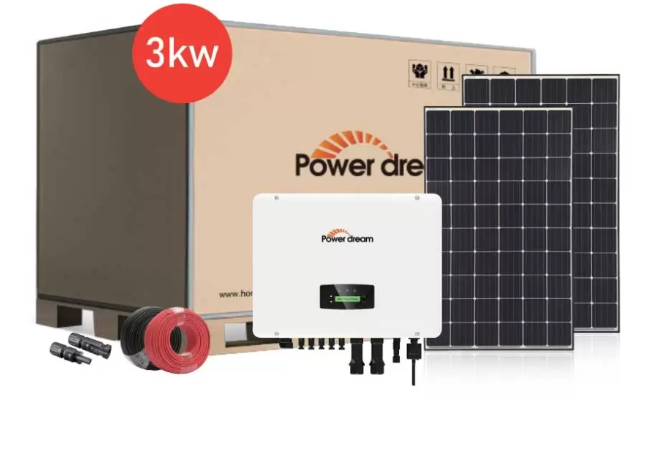The adoption of on grid solar systems has transformed the daily lives of homeowners, businesses, and communities. By connecting PV panels directly to the utility grid, grid-tied solar systems enable a seamless energy exchange—feeding excess power back to the grid and tapping into power when solar generation dips. Grid-tied solar systems will transform daily life, enhance comfort, and reduce costs. We’ll combine industry insights and real-world examples to demonstrate how to adopt grid-tied solar systems, making life greener, more efficient, and more resilient.
Solar On grid System significantly reduce energy bills.
One of the most immediate things people experience after installing a solar on grid system is a reduction in their monthly electricity bill. Because grid-tied solar panels generate power during the day, homeowners can often meet most of their energy needs with clean energy. Net metering programs credit excess power generation to the user’s account, effectively reducing the meter’s operating hours and, therefore, lowering their electricity bills.
For example, a typical 5 kW on grid solar system can generate 20-25 kWh of power per day, depending on the location and panel efficiency. If your home typically uses 30 kWh of electricity per day, solar energy can meet most of that demand, with the occasional shortfall being covered by the grid at off-peak rates. Over time, those savings add up: many homes have a payback period of 4-7 years, after which the electricity is essentially free.
READ MORE : Markets Review A Reliable Forex Broker
Solar on grid system can improve energy independence.
Installing a on grid solar system fosters a sense of energy independence. While the grid connection remains, homeowners are shielded from the power company’s price fluctuations and regional power shortages. When the sun is shining, solar panels generate clean energy directly, reducing reliance on centralized power plants.
In many areas, seasonal or weather-related power outages are a growing concern. While on grid solar systems without battery backup shut down for safety reasons during outages, combining solar panels with smart inverters and future battery systems can fill the gap. This hybrid approach ensures that critical loads such as refrigerators, medical equipment, and lighting remain powered even during grid outages.
Seamless integration with smart homes
Solar on grid systems often come with digital monitoring platforms and smart home control systems. Users can access real-time data on solar generation, home electricity use, and grid output via a smartphone app or web dashboard. With these granular insights, users can shift high-energy-consuming tasks to midday hours when solar output is at its peak.
For example, a 3kW on grid solar system might generate surplus electricity between 10 a.m. and 2 p.m. By programming smart appliances or electric vehicle chargers to operate during these hours, homeowners can maximize their electricity use and minimize grid input. In addition, voice assistants and home energy management systems can automatically adjust these schedules based on weather forecasts or electricity price signals.
Increase Property Value
Real estate studies consistently show that homes equipped with on grid solar systems have higher resale values and sell faster. Buyers recognize the appeal of locked-in energy savings and reduced carbon footprint. Multiple appraisal reports show that installing grid-tied solar panels can increase property values by tens of thousands of dollars.
In addition to complex data, homes with solar installations are also more marketable in environmentally conscious communities. Sellers can show detailed production reports of their on grid solar systems to give potential buyers a clear picture of annual benefits and utility bill deductions. Additionally, the permanence of rooftop solar panels also demonstrates a long-term investment in the property, which means lower holding costs for new owners.
Positive Impact on the Environment
Transitioning to a solar on grid system offers significant environmental benefits. Every kilowatt-hour of electricity generated by solar panels displaces electricity that would otherwise come from a fossil fuel power plant, reducing carbon emissions and air pollutants. A 5-kilowatt grid-connected system can offset 80 to 100 metric tons of carbon dioxide emissions over its lifetime, the equivalent of planting more than 1,000 trees.
In addition to reducing greenhouse gas emissions, solar power generation also reduces particulate matter and nitrogen oxide emissions associated with coal and natural gas power generation. Cleaner air helps improve community environments, reduce respiratory illnesses, and reduce public health costs. Additionally, grid-connected solar systems can facilitate broader integration of renewable energy at the utility level.
Improve Every Aspect of Daily Life
From reducing utility bills and increasing home values to improving air quality and enabling more intelligent electric vehicle charging, solar on grid systems impact nearly every aspect of daily life. By connecting rooftop solar arrays directly to the utility network, grid-tied solar enables consumers to better control their energy use, increase their resilience during power outages, and contribute to the decarbonization of the electricity sector.
